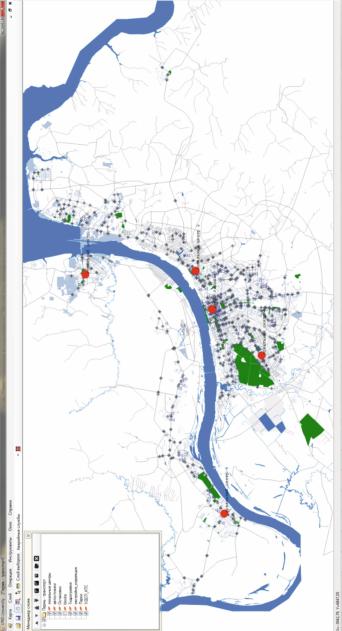
книги / Пространственное развитие городских систем
..pdf48.Brezis E., Krugman P. Technology and the Life Cycle of Cities // Journal of Economic Growth. – 1997. – Vol. 2. – December. – P. 369–383.
49.Bowling alone: America’s declining social capital. An interview with Robert Putnam // Journal of Democracy. – 1995. – Vol. 6. – P. 65–78.
50.Camagni R. On concept of territorial competitiveness: sound or misleading? // Paper presented at the ERSA Conference, Dortmund, august 2002. – URL: http//digilander.iol.it/econreg
51.Camagni R (2009) Territorial impact assessment for European regions: A methodological proposal and an application to EU transport policy. Evaluation and program planning 32: 342–350.
52.Camagni R., Capello R. Macroeconomic and territorial policies for regional competitiveness: an EU perspective // Regional Science Policy & Practice. – 2010. – 2. – 1–19.
53.Caragliu A., Del Boro C., Nijkamp P. Smart cities in Europe. – Amsterdam: University Amsterdam, 2009. – 15 p.
54.Caraveli H., Darzentas J. Centre-Periphery and specialization in the EU // An analysis from a New Economic Geography Perspective. – ERSA 2006, Congress. – 16 p.
55.Cheshire P. Cities in competition: articulating the gains from integration // Urban Studies. – 1999. – 36. – 843–864.
56.Clark C. 1951. Urban Population Densities // Journal of Royal Statistical Sosiety. – Series A. – 114.
57.Colman J. Social capital in the creation of human capital // The American Journal of Sociology. – 1998. – Vol. 94. – P. 95–120.
58.Cooke P, Morgan K. The associational economy. Firms, regions and innovation / Oxford University Press. – Oxford, 1998.
59.Cooke P. Competitiveness as cohesion: social capital and the
knowledge economy // City Matters: Competitiveness, Cohesion, and Urban Governance. – Bristol: Policy Press, 2004. –
P. 153–170.
60.Fukuyama F. Social capital and civil society // International Monetary Fund: сайт. – URL: http: //www.imf.org/external/
151
elib.pstu.ru
pubs/ft/seminar/1999/reforms/fukuyama.htm (дата обращения: 19.01.2012).
61.Financing Urban Shelter: Global Report of Human Settlements 2005. – URL: http: //www.unhabitat.org/content.asp? cid=3392 &catid=7&typeid=46
62.Fujita M., Krugman P. When is the economy monocentric? Von Thunen and Chamberlin uni ed. Regional Science and Urban Economics. – 1995. – Vol. 25. – P. 505–528.
63.Fujita M., Mori T. Frontiers of the New Economic Geography // Papers in Regional Science. – 2005. – September. – P. 377–405.
64.Grajeda M.R., Sheldon I. Trade openness and city interaction, MPRA Paper 18029. – University Library of Munich, Germany, 2009.
65.Giffinger R., Kalasek R., Binger B. Kleinräumige Wirtschaftsent-
wicklung im dicht genutzten Stadtgebiet von Wien. – Stadtenwicklung Wien, 2004. – 78 рp.
66.Giffinger R. Territorial Capital – Understanding and Challenges for a knowledge based strategic Approach // Territorium. – 2008. – No. 8. – P. 7–15.
67.Giffinger R., Stallbohm М. Changes of metropolitan development: strategic efforts in comparison of Barcelona and Vienna // Paper presented at EUR & UAA City Futures Conferences. – Madrid, 2009.
68.Grogan P., Proscio T. Comeback Cities: A Blueprint for Urban
Neighborhood Revival. – Boulder: Westview Press, 2000. –
P. 78–81.
69.Heuermann D.F. Human Capital Externalities in Western Germany / Institute for Labour Law and Industrial Relations in the European Community, 2008.
70.Jacobs J. [Электронный ресурс] // The Commons: сайт. –
URL: http: //www.ecoplan.org/carfreeday/EarthCFD/partners/ writer-jacobs.htm (дата обращения: 19.01.2012).
71.Karlsson C., Johansson B., Roger R. Stough. Human Capital,
Talent and Regional Growth/ CESIS Electronic Working Paper Series. – Paper № 191, 2009.
152
elib.pstu.ru
72.Katharine L., Downs A., Small K. Urban decline and the
future of American cities. – Washington: Brookings Institution Press, 1982. – 309 р. – URL: http: //books.google.
com/books? vid=ISBN0815710534]
73.Kaufmann D., Kraay A., Mastruzzi M. Governance Matters VIII. Aggregate and Individual Governance Indicators 1996– 2008 // Policy Research Working Paper. – Washington: The World Bank, 2009. – P. 80–82.
74.Krugman P., Elizondo R. Trade policy and the Third World metropolis // Journal of Development Economics. – 1996. – Vol. 49. – P. 137–150. – P. 150.
75.Krugman P. Urban concentration: the Role of Increasing returns
and Transport Costs // International Regional Science Review. – 1996. – Vol. 19. – № 1–2. – P. 5–30.
76.Lin N., Fu Y., Hsung R. The position generator: measurement techniques for investigations of social capital // Social capital: theory and research. – New Jersey: Transaction Publishers, 2001. – P. 57–68.
77.Lösch A. Die räumliche Ordnung der Wirtschaft. – Jena: Gustav Fisher, 1944.
78.Maier G., Tödtling F. Regionalund Stadtökonomik. Standorttheorie und Raumstruktur. – Wien, New York: Springer, 1992.
79.Mansori K.S. The Geographic Effects of Trade Liberalization with Increasing Returns in Transportation // Journal of Regional Science. – 2003. – 43 (2). – 249–268.
80.Mills E.S. Studies in the Structure of the Urban Economy. – Baltimore, Johns Hopkins Press, 1972.
81.Muth R.F. Cities and Housing, The Spatial Pattern of Residental Land Use. – The University of Chicago Press, 1969.
82.OECD. Territorial Outlook. OECD. – Paris, 2001.
83.Online Data Analysis [Электронный ресурс] // WVS: сайт. – URL: http: //www.wvsevsdb.com/ (датаобращения: 13.11.2011).
84.Ottaviano G.I.P., Thisse J.-F. New economic geography: what about the N? Environment and Planning. A. – 2005. – Vol. 37. – P. 1707–1725.
153
elib.pstu.ru
85.Parkinson M. The rise of the European entrepreneurial city. – Financing of cities and regions: subsidiarity and finance potentials. East-West Conference. – Munich, October 1996. – P. 125–136.
86.Parr J. Growth pole strategies in regional economic planning: a retrospective view. Part 2: Implementation and outcome // Urban Studies. – 1999. – 36. – 1247–1268.
87.Porter M.J. Competitive advantage, 1998. – URL: http: //www.lofile. com/rus/info/168294
88.Puga D., Venables A. Preferential Trading Arrangements and Industrial Location // Journal of international Economics. – 1997. – 43 (3–4). – 347–368.
89.Puga D., Venables A. Trading Arrangements and Industrial Development // World Bank Economic Review. – 1998. – 12 (2). – 221–250.
90.Raiborde V. Metropolitan Spatial Data Infrastructure Empowering Government Authorities Through Modern Spatial
Tools and Techniques // GIS Development: The Geospatial Resource Portal [Электронный ресурс]. – URL: http: //www. gisdevelopment.net/application/urban/overview/ma06_83.htm
91.Rodriguez-Pose A. The European Union. Economy, Society and Polity. – Oxford: University Press, 2002.
92.Rosenthal S.S., Strange W.C. Evidence on the Nature and Sources of Agglomeration Economies // Henderson J.V. & J.F. Thisse (Eds.). Handbook of Regional and Urban Economics. Vol. 4. Elsevier. – Amsterdam, 2004. – 2119–2171.
93.Scheurer J. «Compact City Policy» // The Urban Reinventors. – 2007. – November, is. 2. – 16 p.
94.Smart cities. Ranking of European medium-sized cities. – Vienna: Vienna University of Technology, 2007. – P. 11–12.
95.Stohr W. On the Theory and Practice of Local Development in Europe // Stohr W. (ed.). Global Challenge and Local Responses. – Mansell Publisher, Londra, 1990.
96.Storper M. The resurgence of regional economies ten years later: the region of untraded interdependencies // European Urban and Regional Studies. – 1995. – 2. – 191–221.
154
elib.pstu.ru
97.Territorial Agenda of the European Union: Towards a More Competitive and Sustainable Europe of Diverse Regions. – URL: http: // bmvbs.de/Anlage/original_1005295/Territorial-Agenda- of-the-European-Union-Agreed-on-25-May-2007-accessible.pdf, 28.1.2008.
98.The Territorial State and Perspectives of the European Union: Towards a Stronger European Territorial Cohesion in the Light of the Lisbon and Gothenburg Ambitions. – Luxembourg Presidency, 2005.
99.Timmer V., Dr. Nola-Kate Seymoar. The world Urban Forum. Vancouver Working Group Discussion Paper. International Center for Sustainable Cities. – Vancouver, 2006.
100.Tran Vinh Tr., Tran Vinh Ph. To apply the GIS for Land-Use and Housing Management in a District of Hochiminh City //
GIS Development: The Geospatial Resource Portal [Электронный ресурс]. – URL: http: //www.gisdevelopment.
net/application/urban/overview/ma03068.htm.
101.Urban Competitiveness Assessment In Developing Country Urban Regions: The Road Forward. The World Bank, Paper prepared for Urban Group, INFUD. The World Bank. – Washington D.C., 2000. – P. 48.
102.Urban Ecology, Innovations in Housing Policy and the Future
of Cities: Towards Sustainability in Neighbourhood Communities [Электронный ресурс]. – URL: http: //www.istp.murdoch.
edu.au/ISTP/publications/jscheurer/urbanecology/
103.Williamson J.G. Regional inequality and the process of national development: a description of the patterns // Economic Development and Cultural Change. – 1965. – 13. – 3–45.
104.Wingo L. Transportation and Urban Land. Washington. Resources for the Future, 1961.
105.Zielenbach S. The Art of Revitalization: Improving Conditions in Distressed Inner-City Neighborhoods. – New York: Garland, 2000. – P. 17.
155
elib.pstu.ru
Приложение
Учебное задание
Расчет показателя транспортной доступности
Показатель транспортной доступности рассчитывается для каждой территориальной единицы (ТЕ) и характеризует состояние транспортной инфраструктуры в непосредственной окрестности ТЕ, а также расположение ТЕ в пределах территории города. Показатель учитывает следующие факторы:
–количество остановок общественного транспорта Nобщ.тр
внекоторой окрестности ТЕ;
–количество автомобильных стоянок Nавт.ст в некоторой окрестности ТЕ;
–расстояние от ТЕ до центра города Rцг;
–расстояние от ТЕ до ближайшего локального центра Rлок. Формула расчета показателя транспортной доступности
выглядит следующим образом:
Kтр.дост = Nобщ.тр · kобщ.тр + Nавт.ст · kавт.ст +
+ (kц.г / Rц.г + 1/ Rлок) · kрасп,
где kобщ.тр – весовой коэффициент значимости остановок общественного транспорта, kавт.ст – весовой коэффициент значимости автомобильных стоянок, kц.г – весовой коэффициент значимости расстояния до центра города, kрасп – весовой и масштабный коэффициент фактора расположение ТЕ в пределах территории города.
Коэффициенты kобщ.тр и kавт.ст рекомендуется выбирать таким образом, чтобы они удовлетворяли условию
kобщ.тр + kавт.ст = 1
и имели значения в пределах от 0,0 до 1,0. Коэффициент kцг может иметь любое значение порядка 1,0. Выбор коэффициента
156
elib.pstu.ru

Рис. П.1. Карта с исходными данными для расчета
157
elib.pstu.ru
kрасп обусловлен преимущественно величинами расстояний до центров и единицами их измерения. В данном расчете для карты города Перми, где расстояния измеряются в метрах, этот коэффициент взят равным 1000,0.
Для проведения расчета следует открыть карту «Пермь– транспорт.uno», которая содержит слои территориальной декомпозиции, остановок, автостоянок илокальныхцентров (рис. П.1).
1. Расчет расстояний
Для расчета индикаторов Rцг и Rлок необходимо открыть окно «Операции / Расчет расстояний». Расчетный слой – это слой, для которого рассчитывается индикатор, слой территориальной декомпозиции. Слой опорных точек – это слой, где находятся точечные объекты, до которых рассчитываются расстояния. Поскольку имеется возможность выбирать конкретную опорную точку, то для удобства, объекты в этом слое должны иметь наименования, по которым их можно идентифицировать. В данной карте слой опорных точек называется «Локальные центры» и имеет поле «Название» (рис. П.2).
Рассчитайте расстояние до центра города, выбрав команду «Рассчитать расстояние до… выбраннойопорнойточки». Поле можно назвать «Расстояние до центра города». Затем получите расстояние до ближайшего локального центра, выбрав команду «Рассчитать расстояние до… ближайшей опорной точки». Назовите поле «Расстояние до локального центра».
2. Агрегирование слоев общественного транспорта
Для расчета индикаторов Nобщ.тр и Nавт.ст необходимо провести агрегирование соответствующих слоев. Согласно данной методике агрегирование проводится в пределах заданного радиуса от центра ТЕ. Значение радиуса выбирается экспертно. В данном примере это значение выбрано равным 500 м (рис. П.3).
Проведите агрегирование, назвав результирующие поля «Остановки – количество» и «Автостоянки – количество» для слоев общественного транспорта и автостоянок соответственно.
158
elib.pstu.ru

Рис. П.2. Расчет расстояний до локальных центров
3. Расчет показателя транспортной доступности
На данном этапе все численные индикаторы для расчета подготовлены. Далее с помощью блока математических операций производится расчет по формуле для Kтр.дост. Схема расчета может быть следующей (в кавычках указаны названия полей):
«1/Rцг» = 1 / «Расстояние до центра города»; «1/Rлц» = 1 / «Расстояние до локального центра»;
159
elib.pstu.ru

«1/Rцг + 1/Rлц» = «1/Rцг» + «1/Rлц»;
«Nобщ.тр + Nавтост» = «Nобщ.тр» + «Nавтост»;
«Rk» = «1/Rцг + 1/Rлц» * 1000;
«Kтр.дост» = «Nобщ.тр + Nавтост» + «Rk».
Также возможен расчет показателя транспортной доступности с помощью встроенного в программу инструментария.
Рис. П.3. Агрегирование слоев общественного транспорта
160
elib.pstu.ru
